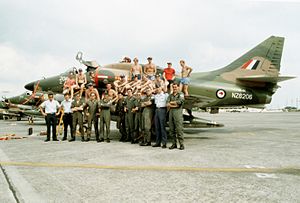75 Squadron RNZAF
| No. 75 Squadron RNZAF | |
|---|---|

Members of No. 75 Squadron RNZAF with one of the unit's A-4K Skyhawks in the Philippines during Cope Thunder in 1982
|
|
| Active | 1 October 1946 – 13 December 2001 |
| Country |
|
| Branch |
|
| Role | Bomber Fighter-attack |
| Size | One Squadron |
| Garrison/HQ | RNZAF Base Ohakea |
| Motto(s) | Ake Ake Kia Kaha (For ever and ever be strong) |
| Mascot(s) | Tiki |
| Anniversaries | 1 October 1946 |
| Equipment | A-4 Skyhawk |
| Engagements |
World War II Malaysian Emergency |
| Insignia | |
| Squadron Badge | Tiki in front of two crossed mining hammers in saltire |
No. 75 Squadron RNZAF was an air combat squadron of the Royal New Zealand Air Force. It was formed from the RAF's World War II bomber squadron, No. 75 Squadron, which had been initially equipped by the New Zealand government and was largely manned by New Zealanders. The squadron was created when, in a unique gesture, the squadron number, colours and battle honours were transferred to the RNZAF in 1946. It had flown more sorties and suffered more casualties than any other in the European theatre.
The squadron ceased to exist on 13 December 2001, when the RNZAF Air Combat Force, comprising Nos 2, 14, and 75 Squadrons, was officially disbanded.
No. 75 Squadron Royal Flying Corps (later RAF) was formed as a home defence fighter unit on 1 October 1916 but disbanded in June 1919 following the end of World War I. The squadron reformed at RAF Feltwell in Norfolk on 15 March 1937 as part of the RAF expansion in the mid-1930s, with transfer of pilots from No. 215 Squadron RAF, being equipped with four Vickers Virginias and seven Avro Ansons for bomber training. The squadron later operated Handley Page Harrows which were replaced by Ansons in 1939, operating again in a training role alongside No 15 Operational Training Unit. Meanwhile, the New Zealand government had ordered 30 modern Vickers Wellington bombers to replace its Vickers Vildebeests in New Zealand. Aircrew were sent to England to train on these new aircraft before flying them back to New Zealand.
...
Wikipedia
